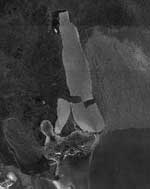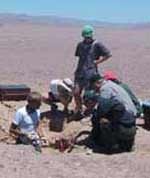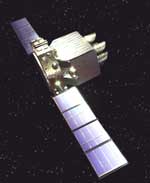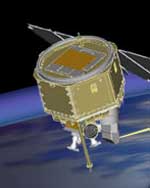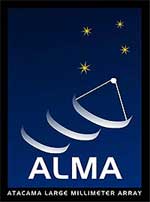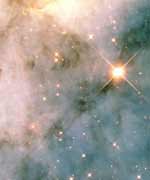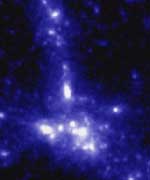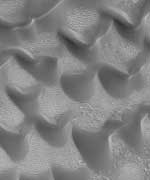
Image credit: NASA/JPL
Mars has the largest volcano, the deepest canyon, and it’s got the biggest sand dunes. Several conditions on the Red Planet, including its low gravity, air pressure and sand probably contribute to the gigantic sand dunes that can form there. Dunes have been seen by the Mars Global Surveyor which reach twice as tall as they get on Earth. The Mars Exploration Rovers, currently on track to reach Mars in early 2004 will have cameras on board that may help scientists take a closer look at the sand that makes up these gigantic dunes.
Mars is kind of like Texas: things are just bigger there. In addition to the biggest canyon and biggest volcano in the solar system, Mars has now been found to have sand ripples twice as tall as they would be on Earth.
Initial measurements of some of the Red Planet’s dunes and ripples using stereo-images from the Mars Orbiter Camera onboard the Mars Global Surveyor have revealed ripple features reaching almost 20 feet high and dunes towering at 300 feet.
One way to imagine the taller dimension of ripples on Mars is to visualize sand ripples on Earth, then stretch out the vertical dimension to double height, without changing the horizontal dimension.
“They do seem higher in relation to ripples on Earth,” said Kevin Williams of the Smithsonian National Air and Space Museum. Williams will be presenting this latest insight into the otherworldly scale of Marscapes on Monday, Nov. 3 at the annual meeting of the Geological Society of America in Seattle, WA.
Ripples are common on Mars and usually found in low-lying areas and inside craters, says Williams. On Earth they tend to form in long parallel lines from sand grains being pushed by water or air at right angles to the ripple lines. Dunes, on the other hand, are formed when grains of sand actually get airborne and “saltate” (a word based on the Latin verb “to jump”). That leads to cusp-shaped, star-shaped, and other dune arrangements that allow materials to pile sand much higher.
How exactly Martian dunes and ripples form is still unknown, says Williams, since the images from space give us no clues to the grain sizes or whether they are migrating or moving in any way. Though there are Viking spacecraft images from almost 30 years ago to compare with, the images do not have the resolution to confirm whether ripples have moved much in that time. For now, the dimensions of ripple-forms on Mars are the only indications of whether they are large ripples or small dunes. Williams’ results came about from the advantageous combination of image parameters to get the first height measurements of these ripple-like features at the limit of image resolution.
According to Williams, it’s likely the doubled heights of Mars ripples relative to their spacing is made possible by the same thing that makes Mars’ volcanoes so tall: lower gravity. With about one-third the gravity of Earth, sand, silt, and dust can theoretically stack up higher before gravity causes a slope failure.
However, other differences could play roles in making these large piles of sand as well. “It could also be from different wind speeds, air densities or other factors,” said Williams. Mars has a perennially subfreezing, very thin atmosphere in which global dust storms have been known to obscure the surface from view.
The study of Mars dunes and ripples has been underway since Viking spacecraft images of Mars first revealed such features in the late 1970s and early 1980s, says Williams. The primary difficulty of the work continues to be in discerning the close-up details, like the exact heights of features and grain sizes. As with dunes and ripples on Earth, these wind-blown features could reveal a lot about local and regional weather and wind currents ? if more was known about ripple and dune building under the very un-Earthlike conditions of Mars.
So far the only close-encounters humans have ever had with Martian dunes were with the Viking Landers and the Pathfinder mission, which sent the Sojourner rover trundling among Martian boulders. “There were some small dunes in the area of Pathfinder,” Williams said.
There are also likely to be ripples or small dunes within range of the far more mobile Mars Exploration Rovers now enroute to the Red Planet, Williams said. The Mars Exploration Rovers, Spirit and Opportunity, are larger and will be able to travel much further than Sojourner, making it more likely they will be taking a closer look at ripples as well as other geological features of Mars.
Original Source: Geological Society of America News Release

